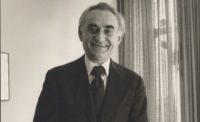Bruce Graham, Architect Who Drove Excellence at SOM, Dies
|
The most visible legacies of Bruce Graham, FAIA, are the Sears (now Willis) Tower and the John Hancock Center, the iconic skyscrapers that bracket Chicago’s skyline like enormous parentheses. But evidence of Graham’s influence can be found in smaller, much-admired Modernist landmarks, such as Chicago’s glistening Inland Steel Building; in the outcome of visionary urban plans, in the tradition of Daniel Burnham, that reshaped Chicago’s celebrated lakefront; and in the hard-driving character of the firm, Skidmore, Owings & Merrill, on which he stamped on indelible imprint.
Invariably described as tough and gruff, an architect who designed in the gutsy, direct manner of himself and his city, Graham, 84, died March 6 of complications from Alzheimer’s disease at his home in Hobe Sound, Florida. He was the most powerful Chicago architect of his generation and was a leader in the 1960s and 1970s, along with SOM structural engineer Fazlur Khan, in shaping a new generation of supertall structures. His SOM acolytes have a more personal series of recollections, including Graham holding court in the wood-paneled confines of a Chicago club, with one hand curled around a double-scotch and the other over a filtered cigarette.
Born in Colombia in 1925, Graham was the son of a Canadian-born international banker and a Peruvian mother. He came to the United States in the 1940s and received his bachelor of architecture from the University of Pennsylvania in 1948. At the advice of Mies van der Rohe, he served an apprenticeship with Chicago architects Holabird, Root and Burgee, then joined the up-and-coming firm of SOM. A series of triumphs followed, beginning with the 1957 Inland Steel Building, co-authored by Graham’s bitter SOM rival Walter Netsch. Inland Steel remains renowned for a muscular, structurally expressive exterior sheathed in stainless steel and column-free interior spaces that results from the placement of elevators and other utilities in an adjoining service tower.
Banco de Occidente
Click on the slide show icon to see additional photos.
Graham’s greatest achievement came in the mixed-use, 100-story Hancock Center of 1970, where the tower’s trademark X-shaped braces helped form a rigid, economical tube that changed the course of super-tall building design. In the 110-story Sears Tower, he and Khan lashed together nine tubes to form a powerfully sculpted “bundled tube” that reached the record-shattering height of 1,451 feet and reigned from 1973 to 1996 as the world’s tallest building. Renamed last year for a British insurance brokerage, the skyscraper remains the nation’s building. Graham also designed corporate headquarters, academic buildings, and other structures around the nation and the world, playing a major role, for example, in the planning of London’s Canary Wharf.
Yet his biggest urban impact was in Chicago, where he worked on the visionary Chicago 21 plan of 1973 that led to the reopening of once-moribund Navy Pier as a lively tourist attraction and the relocation of Lake Shore Drive to create the lakefront cultural complex known as the Museum Campus. He also served as a mentor to such prominent SOM alumni as Adrian Smith, FAIA, and Richard Keating, FAIA who credits him for instilling in SOM both his legendary toughness and his drive for excellence. Said Keating: “His greatest legacy was the engine of the firm that grew in his likeness.”




